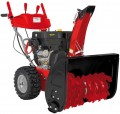Working width
The width of the strip of snow that the snow blower can clear in one pass. The larger the capture width, the fewer passes will be required to process the site, which is especially important on large areas. On the other hand, for processing small spaces, clearing individual paths, etc. significant width is not required (moreover, a “narrow” snow blower will pass more easily in a hard-to-reach place). The larger the capture width, the more powerful the engine, usually, ceteris paribus.
The most compact modern snow blowers have a working width of
less than 50 cm, these are mainly electric models of low power, although gasoline units are also found. A width of
50 – 60 cm can be called relatively small,
60 – 70 cm — medium, and in the largest models this figure
exceeds 70 cm.
Snow height
The maximum thickness of the snow layer that the snow blower removes in one pass. If you plan to regularly remove snow as it falls in a small area (for example, in the courtyard of your own private house), a grip height of up to 20 cm will be enough. If the opportunity to remove snow is rare (for example, in a country house where you visit only on weekends), you should pay attention to more powerful models with a height of about 50 cm.
Max. throw distance
The maximum distance to which the snow blower can throw the collected snow (for models without throwing distance adjustment, the operating range itself). This value is rather arbitrary, since snow can be strongly dispersed in flight. Nevertheless, it characterizes the capabilities of the unit well and allows you to compare it with other models.
Long range is important mainly when working on large areas — it allows you to throw snow across the cultivated area so that it does not have to be collected a second time. As for specific figures, the value
up to 10 m is considered relatively small,
11 – 15 m — average, and in the most "long-range" models this figure can be
16 m or more.
Auger / brush diameter
The diameter of the working tool of the snow blower. Other things being equal (primarily engine power), a smaller diameter auger gives more force during rotation, and a larger diameter auger allows you to process more snow in the same time. Therefore, units with large augers can be recommended primarily for working with large volumes of relatively soft snow, and with small ones — for dense packed cover and crust.
Number of gears
The number of gears in the transmission of a self-propelled snow blower (see "Design"), in fact — the number of speeds at which it can move during operation.
Recall that upshifting increases speed and reduces torque. Thus, high gears are convenient for working with loose snow, which does not give strong resistance, while low gears allow you to cope with dense snow and crust. And the greater the number of gears, other things being equal, the more accurately you can choose the optimal speed. On the other hand, the abundance of settings complicates and increases the cost of the transmission. Therefore, when choosing the number of gears, manufacturers also take into account the overall level of the snow blower: the more powerful and heavier the unit, the more settings it usually provides.
A separate case are units with continuously variable (including hydrostatic) transmissions. They do not have fixed gears, and the gear ratio is automatically adjusted depending on the throttle position and the load on the working nozzle. One of the advantages of such systems is the almost zero probability of slipping, because. the wheels keep the torque at all times. In addition, the transmission itself can play the role of overload protection: when the auger is jammed, it disconnects it from the engine. On the other hand, stepless systems are quite complex and expensive, and automation does not always work exactly the way the user wants; therefore, this option is relatively rare.
Engine size
The size of the engine installed in a gasoline or diesel (see "Engine type") snow blower. With the same type of internal combustion engine (see above), more displacement usually means more power and more fuel consumption.
Motor power
Snowblower motor power in horsepower.
The universal unit of power today is watts, but for petrol and diesel engines (see "Motor type"), the traditional designation in horsepower may also be given. 1 HP approximately equal to 735 watts.
The higher the motor power, the higher the performance of the snow blower, the better it handles with high dense snowdrifts and icy crust. However, more powerful engines consume more fuel, weigh more and cost more, and their use is not always justified. Detailed recommendations on choosing the optimal power for a specific situation can be found in special sources.
Motor power
Snowblower motor power in watts. This designation is used for all electric models; for units with an internal combustion engine (see "Motor type"), the designation in horsepower may also be given (see above).
The higher the motor power, the higher the snowblower's flow rate, the better it copes with high dense snowdrifts and icy crust. However, more powerful engines consume more fuel, weigh more and cost more, and their use is not always justified. Detailed recommendations on choosing the optimal power for a specific situation can be found in special sources.
Fuel tank volume
The amount of fuel that the snow blower tank can hold at one time. Knowing this figure, as well as fuel consumption (see above), you can easily calculate the approximate operating time on one gas station. However, manufacturers usually choose the volume so that the operating time reaches at least 2 – 2.5 hours, so in most cases you can not pay much attention to this parameter.

